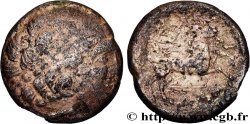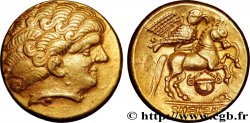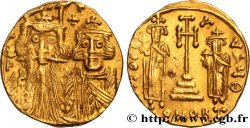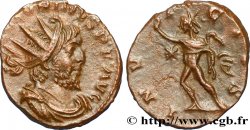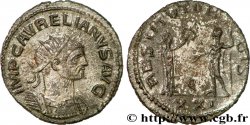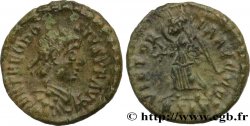bga_242797 - Undetermined Aera of Normandy Quart de statère à l’oiseau conducteur et au chaudron
Not available.
Item sold on our e-shop (2011)
Price : 2 500.00 €
Item sold on our e-shop (2011)
Price : 2 500.00 €
Type : Quart de statère à l’oiseau conducteur et au chaudron
Date: IIIe siècle - début IIe avant J.-C.
Metal : gold
Diameter : 13 mm
Orientation dies : 6 h.
Weight : 1,99 g.
Rarity : R3
Coments on the condition:
Très belle petite monnaie, frappée sur un flan large avec les types de droit et de revers complets et bien centrés
Catalogue references :
Predigree :
Cet exemplaire est en couverture du catalogue CELTIC II
Obverse
Obverse legend : ANÉPIGRAPHE.
Obverse description : Tête chevelue à droite, non laurée, la chevelure exubérante et bouclée.
Reverse
Reverse legend : ANÉPIGRAPHE.
Reverse description : Cheval bondissant à droite, un oiseau conducteur sur la croupe et un chaudron entre les jambes ; ligne d’exergue.
Commentary
Ce quart de statère est excessivement rare ; c’est la première monnaie de cette série “à l’oiseau conducteur et au chaudron” qu’il nous a été donné de proposer à la vente !
Quatre exemplaires sont recensés dans le MONETA VIII, celui de la BN qui provient de Caen (DT. 2060), celui de la vente Leu 81 (DT. 2061), un exemplaire trouvé en Allemagne et un exemplaire à Zurich (?).
Cet exemplaire serait le cinquième publié. La qualité des photographie rend difficile l’établissement de liaisons de coin avec les deux exemplaires DT. 2060 et 2061.
Le quart LT. 6951 est dessiné deux fois dans le LA TOUR (cf. page 127).
This quarter stater is extremely rare; it is the first coin of this series “with the leading bird and the cauldron” that we have been able to offer for sale! Four examples are listed in MONETA VIII, that of the BN which comes from Caen (DT. 2060), that of the Leu 81 sale (DT. 2061), a example found in Germany and a example in Zurich (?). This example would be the fifth published. The quality of the photographs makes it difficult to establish die links with the two examples DT. 2060 and 2061. The quarter LT. 6951 is drawn twice in LA TOUR (see page 127)
Quatre exemplaires sont recensés dans le MONETA VIII, celui de la BN qui provient de Caen (DT. 2060), celui de la vente Leu 81 (DT. 2061), un exemplaire trouvé en Allemagne et un exemplaire à Zurich (?).
Cet exemplaire serait le cinquième publié. La qualité des photographie rend difficile l’établissement de liaisons de coin avec les deux exemplaires DT. 2060 et 2061.
Le quart LT. 6951 est dessiné deux fois dans le LA TOUR (cf. page 127).
This quarter stater is extremely rare; it is the first coin of this series “with the leading bird and the cauldron” that we have been able to offer for sale! Four examples are listed in MONETA VIII, that of the BN which comes from Caen (DT. 2060), that of the Leu 81 sale (DT. 2061), a example found in Germany and a example in Zurich (?). This example would be the fifth published. The quality of the photographs makes it difficult to establish die links with the two examples DT. 2060 and 2061. The quarter LT. 6951 is drawn twice in LA TOUR (see page 127)








 Report a mistake
Report a mistake Print the page
Print the page Share my selection
Share my selection Ask a question
Ask a question Consign / sell
Consign / sell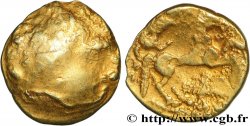
 Full data
Full data
